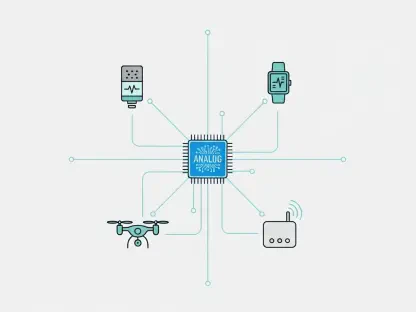In an era of heightened global tensions and rapid technological advancements, the U.S. defense sector stands at a pivotal moment, with the Department of Defense (DoD) redirecting its focus toward warfighting capabilities and cutting-edge innovation under President Trump’s leadership. This strategic shift has ushered in a new wave of substantial contracts, positioning certain companies as key players in bolstering national security. Among them, RTX (RTX) and Palantir Technologies (PLTR) have emerged as standout recipients of massive DoD awards, sparking intense interest among investors. With billions of dollars allocated to enhance military readiness and integrate advanced systems, the defense industry is poised for remarkable growth. This article explores the transformative contracts secured by RTX and Palantir, delving into how these deals reflect broader Pentagon priorities and whether these companies truly represent the most compelling investment opportunities in the current defense landscape.
A New Era for Pentagon Priorities
The Pentagon’s current policies signal a significant pivot, emphasizing military strength and technological superiority over previous non-military initiatives. This redirection comes as a response to escalating geopolitical challenges, with substantial funding now channeled into advanced weaponry, artificial intelligence, and optimized logistics. The DoD’s commitment to maintaining a competitive edge on the global stage has created fertile ground for defense contractors capable of meeting these urgent demands. Billions in contracts are being awarded to ensure the U.S. military is equipped for modern warfare, from missile defense systems to digital transformation projects. This shift not only underscores a renewed focus on national security but also sets the stage for sustained growth within the sector, as government spending aligns with strategic imperatives that prioritize readiness over ancillary programs.
Moreover, this realignment has broader implications for the defense industry’s trajectory. The emphasis on innovation means that companies with expertise in high-demand areas like AI and advanced hardware are likely to see long-term benefits. The DoD’s strategic vision extends beyond immediate needs, aiming to build a military infrastructure that can adapt to future threats. This forward-thinking approach creates a ripple effect, encouraging investment in firms that can deliver scalable solutions. As the Pentagon doubles down on efficiency and effectiveness, the landscape for defense stocks becomes increasingly attractive, with selected contractors positioned to capitalize on both current allocations and future funding waves, reinforcing the sector’s resilience amid global uncertainties.
RTX’s Monumental Contract and Financial Anchor
RTX has secured a landmark position in the defense sector with a $50 billion, 20-year contract from the Defense Logistics Agency, set to run through 2045. This sole-source agreement encompasses production, spare parts, and support for essential systems, with a likely focus on the Patriot missile defense system, which remains critical in ongoing conflicts such as in Ukraine. The sheer scale of this deal ensures a steady revenue stream for RTX, mitigating risks associated with market volatility. Beyond financial predictability, the contract highlights RTX’s entrenched role within the defense industrial base, where its expertise in hardware and logistics is unmatched. For investors, this translates into a compelling mix of stability and growth, as global demand for missile defense continues to surge in response to international tensions.
Additionally, RTX’s diversified income sources further solidify its appeal as a reliable investment. The company’s robust order backlog, fueled by both domestic and international needs, positions it to weather economic fluctuations while capitalizing on rising defense budgets. This contract not only strengthens national security by replenishing critical arsenals but also cements RTX’s status as a cornerstone of military infrastructure. The long-term nature of the deal provides a buffer against short-term uncertainties, offering a predictable growth path that appeals to cautious investors. As the defense sector evolves, RTX’s ability to deliver on large-scale, mission-critical projects ensures it remains a key player, blending traditional contractor reliability with exposure to expanding global markets.
Palantir’s Role in Digital Warfare Transformation
Palantir Technologies has carved out a unique space in the defense arena with a $10 billion, 10-year enterprise agreement with the U.S. Army, extending through 2035. This contract consolidates various initiatives into a cohesive framework for AI, data analytics, and software solutions, placing Palantir at the forefront of the DoD’s digital overhaul. As modern warfare increasingly relies on data-driven decision-making, the company’s platforms offer strategic advantages, from optimizing operations to enhancing battlefield intelligence. This deal not only underscores Palantir’s technological prowess but also signals the military’s growing dependence on digital tools, creating a high-growth opportunity for a firm that bridges defense needs with cutting-edge innovation across multiple branches.
Furthermore, Palantir’s positioning in this space offers investors a glimpse into the future of military strategy, where software and AI play pivotal roles. Unlike traditional hardware-focused contractors, Palantir’s emphasis on scalable tech solutions allows it to adapt swiftly to evolving DoD requirements. The potential for its platforms to be integrated across various military domains amplifies its growth prospects, making it an attractive pick for those seeking exposure to disruptive innovation within a stable sector. This contract reflects a broader trend of digital transformation that could redefine defense operations, positioning Palantir as a leader in an area poised for exponential expansion. As geopolitical complexities mount, the company’s contributions to strategic efficiency could prove indispensable, enhancing its long-term investment value.
Industry-Wide Shifts and Growth Potential
The defense sector as a whole is undergoing profound modernization, driven by the urgent need to address intricate global challenges and maintain national security. The DoD’s strategic investments in missile defense, logistical efficiency, and digital capabilities point to a sustained commitment to innovation and preparedness. This trend bodes well for contractors like RTX and Palantir, whose expertise aligns directly with these priorities. Their ability to deliver on critical military needs positions them as integral to the Pentagon’s vision, offering investors a dependable avenue to tap into a market characterized by government-backed contracts and long-term growth. The sector’s resilience, fueled by consistent defense spending, further enhances its allure amid economic uncertainties.
Beyond immediate contracts, the broader industry outlook suggests a trajectory of expansion as technological integration becomes a cornerstone of military strategy. The focus on readiness ensures that funding will likely remain robust, benefiting companies that can innovate while meeting stringent operational demands. For RTX, this means continued relevance in hardware and systems support, while Palantir stands to gain from the accelerating adoption of AI-driven solutions. This dual dynamic within the sector highlights a unique investment landscape, where stability and innovation coexist, creating diverse opportunities. As global threats evolve, the defense industry’s adaptability will likely drive sustained interest, positioning well-aligned contractors for significant returns over the coming years.
Diverse Investment Profiles in Defense
RTX and Palantir present contrasting yet complementary opportunities for investors navigating the defense market. RTX, with its deep-rooted presence in traditional defense manufacturing, caters to those prioritizing steady returns through its focus on hardware and logistics. Its massive contract provides a foundation of reliability, appealing to risk-averse portfolios seeking consistent performance. The company’s established track record and extensive backlog further reinforce its status as a safe harbor within a volatile global environment. Investors drawn to predictability will find RTX’s entrenched position and diversified revenue streams a compelling reason to allocate capital, especially as defense budgets expand to address ongoing and emerging conflicts.
In contrast, Palantir embodies the transformative potential of technology within defense, attracting investors with an appetite for rapid growth and innovation. Its focus on AI and data analytics positions it as a disruptor, offering exposure to the military’s digital future. This high-growth profile suits those willing to embrace volatility for the promise of substantial upside, particularly as the DoD leans further into tech-driven strategies. The interplay between RTX’s stability and Palantir’s forward-looking approach illustrates the sector’s breadth, where different risk tolerances can find suitable entry points. As the defense landscape continues to evolve, these distinct profiles highlight the multifaceted nature of investment opportunities available to discerning market participants.
Strategic Moves for Defense-Focused Portfolios
Reflecting on the developments within the defense sector, it becomes evident that the substantial contracts awarded to RTX and Palantir mark a defining moment for military modernization. These deals, valued at $50 billion and $10 billion respectively, capture the Pentagon’s dedication to enhancing combat readiness through advanced systems and digital solutions. RTX’s role in sustaining critical hardware underscores its reliability, while Palantir’s contributions to AI and data analytics point to a tech-centric military evolution. Both companies play pivotal roles in aligning with national security goals, demonstrating how strategic partnerships shape the industry’s direction.
Looking ahead, investors might consider balancing portfolios by integrating the stability of RTX with the growth potential of Palantir, capitalizing on the dual strengths of hardware and technology. Monitoring future DoD funding trends and geopolitical developments could provide further clarity on sustaining momentum in defense investments. Exploring additional contractors with emerging contracts might also diversify exposure, ensuring resilience against market shifts. As the sector adapts to new challenges, staying informed about policy changes and technological advancements remains crucial for maximizing returns in this dynamic landscape.









